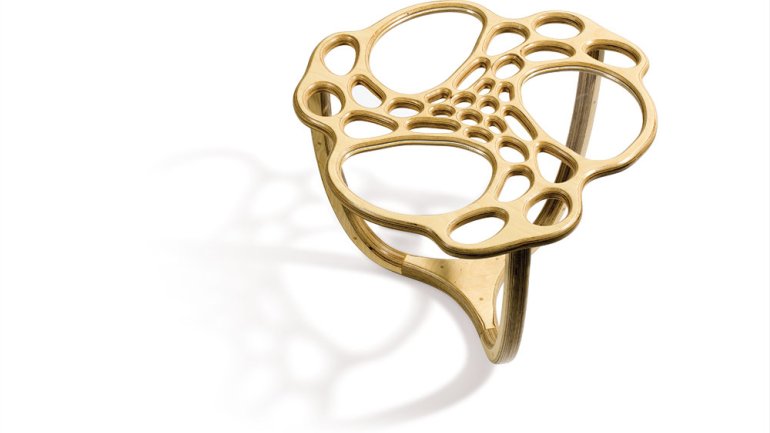Code Craft
Code Craft
At this year’s International Contemporary Furniture Fair, Jessica Rosenkrantz and Jesse Louis-Rosenberg, the duo behind Nervous System, didn’t just show their product: striking new tables and modern light fixtures that evoke organic forms. They also brought the design process directly to their customers. Their interactive software allowed eager ICFF-goers to create their own versions of the studio’s Radiolaria tables, down to each table’s cellular-inspired shape, number of legs, and height.
The Radiolaria custom furniture application is the latest of Nervous System’s design apps, which Rosenkrantz and Louis-Rosenberg use to design jewelry, housewares, and now furniture. Their custom-crafted software mimics natural processes and patterns such as cellular division and particle aggregation. And this algorithmic approach to design, paired with technologies such as laser cutting, 3D printing, and CNC routing, allows the couple to produce large numbers of one-of-a-kind works at surprisingly low prices – what they call “mass customization.” Objects are similar, but each is unique, like snowflakes, leaves, and other forms we see in nature.
“Our business model has always been to make things that are very interesting and intellectual, and to keep them at a price point that is accessible to everyone,” Rosenkrantz says. She and Louis-Rosenberg launched Nervous System in 2007, while both were in school: Rosenkrantz for a graduate degree in architecture, and Louis-Rosenberg for math and computer science. One day, Rosenkrantz was constructing a model of a cellular building, and scraps of her material, laser-cut with an algorithmic pattern, were attracting attention scattered about on her desk. “One person asked if they were bracelets, and I thought, ‘Why not?’ ”
Louis-Rosenberg created his own algorithms – which became Nervous System’s coral-like Dendrite collection – and an Etsy shop was born. “We decided we’d be happier making this sort of work and sharing it directly with the public,” says Rosenkrantz, “so we dropped out of school and started doing this full time.”
Later that year, they launched their own website, where they not only sold their increasingly popular goods, but also shared the programs they used to design them, a process they call co-creation. “It just made sense that since we worked through code, to open that up for other people,” Rosenkrantz says. They spruced up the software to make it easy for everyone – computer-savvy or no – to “engage in the logic of creation.”
Designing a Cell Cycle bracelet with the web app is smooth and satisfying: With a few clicks of the mouse, you can adjust layers and dimensions, play with different colors and materials (from neon-pink nylon to gold or platinum), and customize cell shape and thickness. “The final project is a collaboration,” Rosenkrantz says.
Depending on the piece, components are produced in the team’s studio in Somerville, Massachusetts, or created through manufacturing partnerships. The Cell Cycle bracelet design, for example, first goes to the design studio’s 3D-printing partner (and if the customer-designer opts for gold plating, it will make a quick stop at a plating shop as well).
Ultimately, the bracelet spends some quality time back at the Nervous System studio for finishing. Other products – their cool, contemporary jigsaw puzzles, Radiolaria tables, and anything else laser-cut or CNC-routed – are produced entirely in-house.
“What excites me about the internet and these more accessible manufacturing technologies,” Rosenkrantz says, “is that we can cut out the middleman, and encourage more direct interaction between the artist and the customer.”
Danielle Maestretti is a frequent contributor to American Craft.




